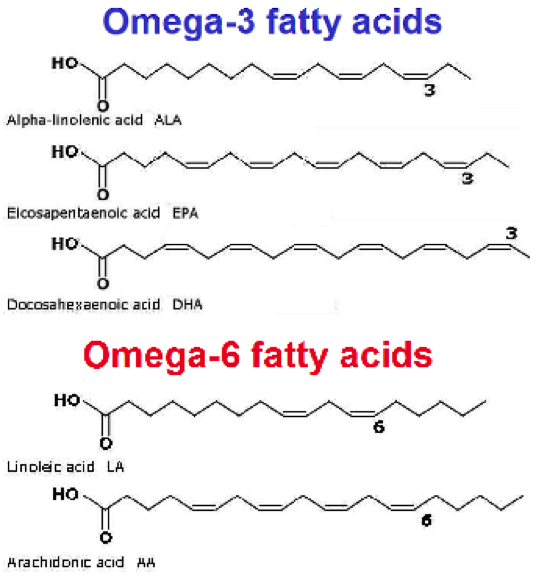Omega-3’s & 6’s
We’ve all heard that supplementing with omega-3s and fish oil is a good idea. It has something to do with inflammation, right? Here’s the simplified explanation as to why.
Omega-3 and Omega-6 fatty acids are essential in the diet; our bodies cannot make them from other fat sources, so they must be consumed. These fats go on to play a number of biochemical roles; controlling inflammatory reactions, supporting the integrity of cell membranes, allowing proper trafficking of nutrients and waste in and out of cells, reducing the incidence of cancer,and promoting proper neurological balance (i.e. memory), among many other benefits.
For the nerdist: Omega’s get their name based on the structure of the acid. Each peak (or angle) represents a carbon atom and the horizontal double line at position indicates a “double bond” between carbon atoms. The position of this double bond from the end opposite the “HO” determines its “omega” number. For the omega-3, this double bond happens at the 3rd carbon. For the omega-6, it happens at the 6th carbon. Simple as that. Refer to the diagram.
While we need both omega types, too much of a good thing is a bad thing. Ideally, we want the ratio of omega-6 to omega-3 to be 2:1. The typical American diet is on the order of 20:1. We consume way, way more omega-6 fats than -3. Mostly found in vegetable oils, like grapeseed, corn, and soybean (used a TON in restaurant cooking), these fats sneakily find their way into our food on a daily basis. Even chicken fat is a concentrated source.
Too many omega-6s promote inflammation in the body. While some is actually anti-inflammatory, there is a spillover when we consume too much. It’s the spillover that sets up an inflammatory environment. Refer to the second diagram.
Refer to the final table to get an idea of where some of the highest concentrations of omega-6 hangout.
Omega Structure. The type of Omega fatty acid is determined by the position of the first double bond OPPOSITE the end of the HO



